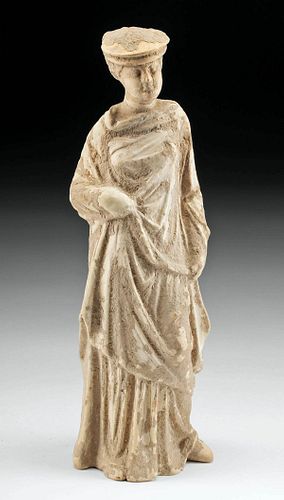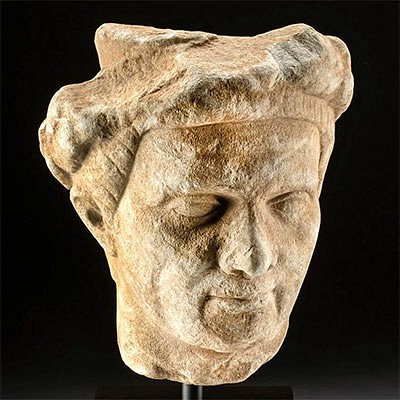Greek Tanagra Pottery Votive Figure of a Female, TL'd
Lot 17
About Seller
Artemis Fine Arts
686 S Taylor Ave, Ste 106
Louisville, CO 80027
United States
Selling antiquities, ancient and ethnographic art online since 1993, Artemis Gallery specializes in Classical Antiquities (Egyptian, Greek, Roman, Near Eastern), Asian, Pre-Columbian, African / Tribal / Oceanographic art. Our extensive inventory includes pottery, stone, metal, wood, glass and textil...Read more
Categories
Estimate:
$1,500 - $2,250
Absentee vs Live bid
Two ways to bid:
- Leave a max absentee bid and the platform will bid on your behalf up to your maximum bid during the live auction.
- Bid live during the auction and your bids will be submitted real-time to the auctioneer.
Bid Increments
| Price | Bid Increment |
|---|---|
| $0 | $25 |
| $300 | $50 |
| $1,000 | $100 |
| $2,000 | $250 |
| $5,000 | $500 |
| $10,000 | $1,000 |
| $20,000 | $2,500 |
| $50,000 | $5,000 |
| $100,000 | $10,000 |
| $200,000 | $20,000 |
About Auction
By Artemis Fine Arts
Jun 1, 2023
Set Reminder
2023-06-01 10:00:00
2023-06-01 10:00:00
America/New_York
Bidsquare
Bidsquare : Ancient | Asian | Ethno | Native American Art
https://www.bidsquare.com/auctions/artemis-gallery/ancient-asian-ethno-native-american-art-12905
Featuring classical antiquities, ancient, and ethnographic art from cultures encompassing the globe. Egyptian, Greek, Roman, Near Eastern, Asian, Pre-Columbian, Native American, African / Tribal, Oceanic, Spanish Colonial, Fossils, more! All legally acquired, legal to sell. Satisfaction guaranteed. Artemis Fine Arts info@artemisfinearts.com
Featuring classical antiquities, ancient, and ethnographic art from cultures encompassing the globe. Egyptian, Greek, Roman, Near Eastern, Asian, Pre-Columbian, Native American, African / Tribal, Oceanic, Spanish Colonial, Fossils, more! All legally acquired, legal to sell. Satisfaction guaranteed. Artemis Fine Arts info@artemisfinearts.com
- Lot Description
Ancient Greece, Tanagra, Hellenistic Period, ca. 3rd century BCE. A stunning pottery female, boasting expertly rendered and impressively preserved details as she stands contrapposto, hands grasping at the multitudes of billowing folds of her chiton and himation that cascade down her slender figure. Crowned by a slightly conical tholia hat, her thick coiffure is piled into an elegant, 4-sectioned bun as her idyllic visage gazes forward presenting petite eyes, a naturalistic nose, full cheeks, and plump lips. The rich fabric of her drapery beautifully complements the feminine curves of her body, stretching across her bosom and flowing down her sloped shoulders and voluptuous hips. Size: 3.5" W x 10.6" H (8.9 cm x 26.9 cm)
During the Hellenistic Period, Greeks had access knowledge about the past through institutions like the Library of Alexandria, creating a sense of history and connection to the Greeks who had come before them. Prominent Hellenistic art collectors commissioned pieces based on public statues from the earlier Classical Period, and smaller, more available art forms like this sculpture echoed the naturalistic, detailed classical style. Terracotta figures like this one have been found in private dwellings where they may have been part of a shrine or had a religious purpose. Others decorate tombs and sanctuaries - in Tanagra, the site that this style of figure is named for, some graves have up to a dozen of these statuettes. Perhaps they represented mourners, dressed in finery to attend a funeral.
'Tanagras' are named after the site in Boeotia, central Greece, where thousands of similar figures were unearthed in the early 1870s. Figures of men, children and comic actors were also found at Tanagra, but standing female figures are the most numerous. The chief appeal of Tanagra figures lies in their exceptional artistic quality usually considered to be the finest of all Greek figurines. The ladies are normally depicted in casual poses and their clothes, which usually consist of a thinner undergarment, the chiton, worn beneath a thicker cloak or himation, are typically pulled and twisted in pleasing patterns which emphasize the form of the figure beneath. Most Tanagra figures are mold made and sometimes have a vent cut in the back to ensure even distribution of heat in the firing. After firing, the figure was coated in a white slip, often a solution of chalk or white clay, and then colors were added on top. The artists who produced these figures were known as coroplasts, literally 'modelers of girls.'
This piece has been tested using thermoluminescence (TL) analysis and has been found to be ancient and of the period stated. A full printed and bound report will accompany the item upon purchase.
Provenance: ex-John Hurter collection, Palm Springs, California, USA, prior to 1995
All items legal to buy/sell under U.S. Statute covering cultural patrimony Code 2600, CHAPTER 14, and are guaranteed to be as described or your money back.
A Certificate of Authenticity will accompany all winning bids.
We ship worldwide and handle all shipping in-house for your convenience.
#178938Expected surface wear with some minor areas of chipping as well as nicks and abrasions, all commensurate with age. Otherwise, intact and excellent with nice remaining detail and rich earthen deposits throughout. TL holes to base and upper left side of vent hold on verso.Condition
- Shipping Info
-
All shipping is handled in-house for your convenience. Your invoice from Artemis Gallery will include shipping calculation instructions. If in doubt, please inquire BEFORE bidding for estimated shipping costs for individual items.
-
- Buyer's Premium



 EUR
EUR CAD
CAD AUD
AUD GBP
GBP MXN
MXN HKD
HKD CNY
CNY MYR
MYR SEK
SEK SGD
SGD CHF
CHF THB
THB














